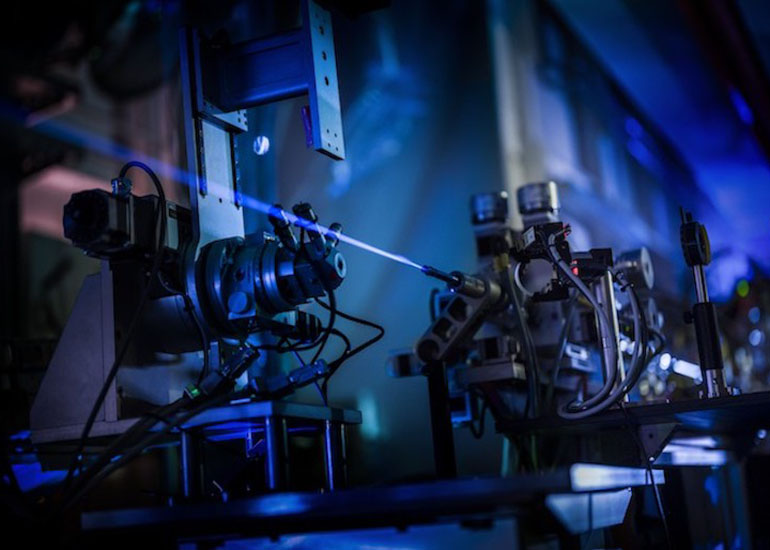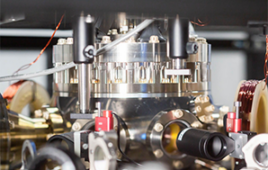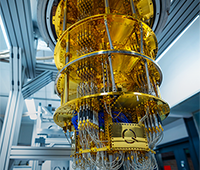By Ken Strandberg

On these images, the X-ray beam appears as a thin blue beam – what we are actually seeing, however, is glowing nitrogen molecules which the extremely intense X-ray beam has interacted with and caused to light up as the beam travels through the air. Even though the European XFEL X-ray beam is extremely intense, the induced glow of the nitrogen molecules is, however, still relatively weak and not so easy to see with the naked eye. These images taken at the FXE instrument were only possible in complete darkness and using an exposure time of 90 seconds.
The European X-ray Free-electron Laser (European XFEL), recently completed its first experiments that captured images of an antibiotic-disabling enzyme. Scientists use X-rays to bombard molecules and project molecular smatterings on a sensor that reconstructs what the target looks like. With these high-energy X-rays we now have 3D visualizations of actual molecules, like proteins, never before seen.
Technology developments like this that leverage high-energy lasers, X-rays, and plasmas are possible due to some very smart people with incredible patience and perseverance, a lot of math, and supercomputers. At the Universidad Politécnica de Madrid (UPM) (Technical University of Madrid), researchers in its Instituto de Fusión Nuclear use high-energy density physics to simulate reactions taking place inside fission and fusion reactors. But, according to José Manuel Perlado, the Chair of Nuclear Physics at UPM and Director of the Instituto de Fusión Nuclear, many of the 2D and 3D computing codes that researchers use for nuclear simulations have application for other research, such as involving X-rays.
For example, some scientists in the Institute are working on next-generation X-ray optics that will allow researchers to probe molecular and atomic structures more deeply (such as being done by the European XFEL), modeling future materials for solar cells, and gaining insights into how to form and manipulate nanoparticles using lasers and plasmas. Their work is made possible with help from the supercomputing power of UPM’s latest supercomputer, Magerit-3, a 68-node cluster built by Lenovo on their ThinkSystem SD530 servers with Intel Xeon Gold 6230 processors totaling 2,720 cores. According to Perlado, Magerit-3 is instrumental in the discoveries that researchers are able to make.
Magerit, meaning ‘place of many waters’, is the ancient Arabic name for Madrid, the city in which UPM and its computing center hosting Magerit — the Centro de Supercomputación y Visualización de Madrid (CeSViMa) (Supercomputing and Visualization Center of Madrid) — reside. CeSViMa offers High Performance Computing (HPC) and interactive visualization services using specialized software for engineering, energy, and the environment running on one of the most powerful supercomputers in the country.
Lasers, Plasmas, and X-rays
Eduardo Oliva Gonzalo is a postdoctoral researcher within the Instituto de Fusión Nuclear. His research is in the amplification of X-rays.
“I am mainly interested in the interaction of lasers with plasmas,” said Oliva Gonzalo. “The plasmas might be long, and the wavelength of the laser is really short, perhaps only centimeters, millimeters, or tens of nanometers. The challenges I face are multi-scale. I need to simulate these plasmas, but at very high resolution. You need HPC to do that.”
His project started about a year ago. Part of his work involves using 2D and 3D codes, including a new 3D Maxwell’s equation solver called EMCLAW. Prior to working with Magerit-3, he had used much smaller computational systems, including homemade Beowulf clusters.
“You cannot do this kind of research on small clusters,” he explained. “The computations are too big for the memory of smaller computers.”
Oliva Gonzalo is still working on simulations, processing the data, and doing new simulations. He expects to show some interesting results in the field of X-ray optics as the work progresses over the next year.
Creating Plasmonic Nanoparticles
Oliva Gonzalo, along with fellow scientists Associate Professor Antonio Rivera de Mena and postdoctoral researcher Ovidio Peña Rodriguez, participate in one of the European Cooperation in Science and Technology (COST) “Actions” to understand and model intense electronic excitation on materials.
“Our objective,” explained Rivera, the chair of the Action “is to formalize computational methods to understand what happens when you irradiate materials with intense electronic excitation.” Essentially, they blast a material of interest with very high-energy lasers and X-rays that create plasmas and study what it does to the material and the processes involved.
One of their projects toward this formalism is in the area of plasmonic nanoparticles. Nanorods are of great interest because of their optical properties at nanoscales. Their applications can cover a wide range of fields, including photovoltaics, imaging, sensing, energy production, and others. Nanorod properties depend on material, size, shape, and composition and the surrounding medium. Methods are continually sought to generate new structures that offer particular properties. Irradiation with femtosecond lasers induces physical changes of the nanorods, leaving them with the desired properties. Their work has produced several insights into how irradiation can shape gold and silver nanorods.
For Rivera and Oliva Rodriguez, irradiation not only lets them explore new nanoparticles, but allows them to study the dynamics of the process. It helps them to provide quantitative answers about the response of materials to intense electronic excitation and to formalize methods for the COST Action.
“We try to understand the structure using molecular dynamics, and the optical response by solving Maxwell equations using very complex geometry,” explained Rodriguez.
“And we are including now the description of the electronic evolution upon irradiation,” added Rivera, “to provide a general overview of what is happening to the electronic system. For example, when a nanoparticle is irradiated, we want to know whether or not electrons are emitted from the plasma, how energy is transferred to the lattice, how the lattice gains energy and heats up, and how it dissipates that heat to the surrounding medium. In order to do that, we need different methods and codes to understand the process. Our COST Action objective is to couple these codes to make them run as a single process in a unified manner.”
To do those calculations requires heavy computation capabilities and memory. According to Oliva Rodriguez, some of them took weeks to complete or were impossible before the installation of Magerit-3.
“Now they can be done in a matter of days” he concludes.
According to Rivera, one of their quantum mechanics codes runs five times as fast on Magerit-3 compared to their previous system, Magerit-2.
“That is just from the faster processors in the cluster,” stated Rivera, “since the code cannot be parallelized. As we unify the COST Action codes and parallelize them, we expect to achieve a much faster speed-up.”
Besides the work with nanoparticles, the three colleagues are interested in the interaction of intense electronic excitation on various materials. Eduardo Oliva Gonzalo’s specialty lies in the area of X-rays and X-ray accelerators, such as the one at European XFEL.
“We use X-rays as opposed to visible light lasers,” described Oliva Gonzalo, “because of their short wavelengths in order to irradiate matter, such as proteins and viruses, to obtain an image of the molecule. But, in X-ray lasers, the flux of photons is so high that you blow up your sample, you create a nanoplasma. We need to really understand this new state of matter.”
The place they begin that understanding is with simulation and Magerit-3.
The Future of Solar Energy Production
For nearly a decade, a class of man-made materials called perovskites has been a focus of research for replacing traditional silicon solar cells with more efficient and less costly to manufacture materials. During this period, perovskites have reached a level of efficiency that competes with crystalline silicon photovoltaic technology, while its open-circuit voltage compared to the band gap rivals state of the art technologies and surpasses silicon. Today, some solar panels are manufactured with a combination of silicon and perovskite cells. But perovskite-based cells lack long-term stability. The material is sensitive to humidity, temperature, and oxygen, causing its performance to degrade.
Perovskites consist of an organic cation, an inorganic cation, and halogen anion. In solar cells these historically have been a combination of methylammonium or formamidinium, lead, and chloride. Professor Pablo Palacios and Assistant Professor Pablo Sanchez-Palencia, from the Grupo de Cálculos Cuánticos of Instituto de Energía Solar, are exploring new combinations of perovskites with other materials to create a more stable solar cell. “We are looking for eco-friendly materials to replace the lead, because lead is so toxic”, stated Palacios. This is a complicated and computationally demanding process involving Density Functional Theory (DFT).
They are treading into new territory because some of the mechanics and the reasons of how their perovskites work as they do are still unknown. “We are in the beginning theoretical stages of the research, doing calculations for combinations of different components”. So, they are first calculating and modeling before they can proceed to experimental stages with other scientists.
“We have reproduced the electronic structure,” added Sanchez-Palencia, “and now we are trying to develop different structures between the perovskites and other materials to extract electrons and holes to be more efficient.”
Their calculations are computationally expensive, both in terms of processors and memory, often involving hundreds of cores on Magerit-3. All their advances accomplished thanks to CeSViMa resources can be found in their webpage.
Magerit-2 Lives On While Magerit-3 Enables New Research
While Magerit-3 provides supercomputing services for UPM researchers, enabling breakthroughs in a variety of scientific disciplines, Magerit-2 lives on in the CeSViMa. According to Oscar Cubo Medina, Technical Director for CeSViMa, as Magerit-3 goes into production, the existing technologies are redeployed to provide storage, virtualized private servers (VPS), and other services across the institution for the University’s 40,000 students.
For Oliva Gonzalo, Rivera, Rodriguez, Palacios, and Sanchez-Palencia, Magerit-3 is a welcome resource that will enable them to continue advancing their areas of research.
Ken Strandberg is a technical storyteller. He writes articles, white papers, seminars, web-based training, video and animation scripts, and technical marketing and interactive collateral for emerging technology companies, Fortune 100 enterprises, and multinational corporations. Mr. Strandberg’s technology areas include Software, HPC, Industrial Technologies, Design Automation, Networking, Medical Technologies, Semiconductor, and Telecom. He can be reached at [email protected].




very good jon admin. very useful to me tahnxss